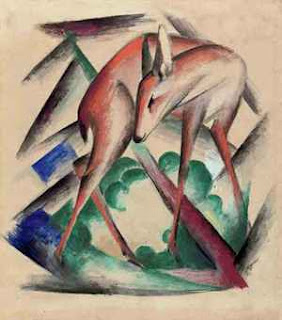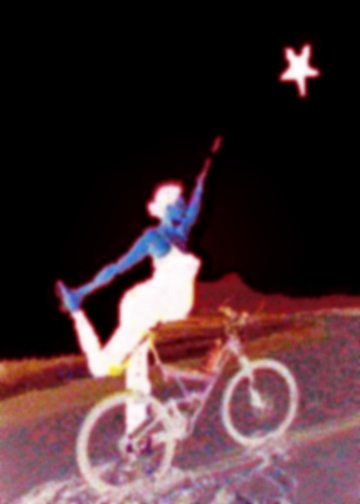 |
| Franz Marc' "Reh" |
I love Franz Marc's work. This beautiful piece is being auctioned at Christies sale:
Impressionist/Modern Evening Sale - February9, 2011 -London, King Street -Online at: http://www.christies.com/LotFinder/searchresults.aspx?action=refine&intSaleID=23150&sid=27906e79-de06-4463-8688-46597c27f25c&t=1296156407185#action=search&intSaleID=23150&sid=27906e79-de06-4463-8688-46597c27f25c
Lot Notes
'What does the deer have in common with the world we see? Does it make any reasonable or even artistic sense to paint the deer as it appears on our retina, or in the manner of the Cubists because we feel the world to be cubistic? Who says the deer feels the world to be cubistic? - it feels it as a deer, and thus the landscape must also be 'deer' ... I could paint a picture called 'The Deer'. Pisanello has just done that. But I may also want to paint 'The Deer Feels'. How infinitely more refined a sensitivity must a painter have to paint that!' (Franz Marc, 'How does a Horse See the World?', 1911, quoted in K. Lankheit, ed., Franz Marc: Schriften, Cologne, 1978, p. 99.)(1)
One of the very finest of Marc's tempera paintings, Reh is an holistic semi-abstract fusion of dynamic intersecting lines of force, figurative form and rich, radiant colour, executed in 1912, at the very height of the artist's self-defined mission to devise an 'animalised' art. The aim of such 'animalisation', as Marc described it, was to render a vision of the world as it might be seen from within - through the feeling and the senses of the living sentient beings (animals and man), who inhabited it. Reh is an extraordinarily elegant, simple and stunningly composed painting that powerfully asserts itself as an icon of this visionary aim.
One of a series of groundbreaking and revolutionary paintings of lone deer enveloped in their natural environment that Marc produced between 1912 and 1913, Reh is a work that belongs amongst the very greatest of Marc's artistic achievements. For Marc, the deer, more than any other animal, symbolized the innocence, fragility and preciousness of animal life as well as what he believed to be its pervasive suffering. Perhaps inspired by a story by one of his favourite authors, Gustave Flaubert's La légende de Saint-Julien,(2)
throughout 1912 and 1913 Marc employed the image of a lone deer sheltering in the forest, threatened by an unseen presence and at the mercy of the violent destructive forces of nature, in a series of ambitious semi-abstract Cubo-Futurist paintings such as Reh im Wald II (Lenbachhaus Museum, Munich), Reh im Klostergarten (Lenbachhaus Museum Munich,) and Tierschicksale (Kunstmuseum Basel). In these works, culminating in his masterpiece Tierschicksale (The Fate of the Animals), Marc encapsulated the central themes of his work. Here, his holistic view of the cosmos and of a spiritualised vision of the world, as seen by innocent animals sensitive to hidden unseen forces and presences, is rendered in semi-abstract form and pulstaing colour, derived from Delaunay and the Italian Futurists, to present a poetic vision of the life of the world on the point of dramatic change. Merging dynamic abstract forces, cubo-futuristic planes and fragmentation, the deer stand at the centre of these paintings and symbolize, as they had in Flaubert's Saint - Julien, innocent victims threatened by a vast unknown destructive force. Prophetic of calamity and, as many have pointed out, also perhaps of the forthcoming deluge of the Great War in which Marc himself would die, these paintings are intimations of the Apocalypse which Marc believed would mark the beginning of a new age of the Spirit. If his blue horse was his symbol of this forthcoming age, the deer was the image he used for the necessary sacrifice of innocence that would have to precede it.
'I am seeking a feeling for the organic rhythm in all things, a pantheistic empathy into the shaking and flowing of the blood in nature, in trees, in animals, in the air', Marc had written in 1910. 'I see no happier means to the 'animalisation of art', as I would like to call it, than the animal picture. Therefore I treat it accordingly' (Franz Marc, 'Letter to Reinhard Piper', 20 April, 1910, in G. Meissner, ed. , Franz Marc, Briefe, Schriften und Aufzeichenungen, Leipzig, 1980, p. 30).(3)
Reh is a work that expresses this 'pantheistic empathy' and the invisible 'organic rhythm' existing between 'all things' through its formal synthesis of solid form - animal, mountain, trees etc - and abstracted kraftlinien or force-lines derived from the Italian Futurist art he had recently seen at the Der Sturm Gallery exhibition of their work.
With the aim of creating 'symbols for their own time, symbols that will take their place on the altars of a future spiritual religion', it was Marc's intention to reveal, through his work, the 'magic, sympathetic bond between the earth and the organic forms it has engendered, earth and object... blended together' (Franz Marc, Almanac Der Blaue Reiter, Munich, 1912, p. 6 and F. Marc, 'Geistige Güter', in Der Blaue Reiter, 1965, p. 21) (4)
This symbiotic sense of interdependence between animal and landscape and the holistic universal nature of all things is expressed in Reh through a subtle abstracting tendency that Marc has used to blur the boundaries between abstract graphic mark and figurative image. The slightly elongated forms of the deer and the rhythm of her legs are echoed by angled brush lines delineating trees and mountains behind. In this way the painting becomes as much a cubo-futuristic construction of intersecting dynamic form as in a work such as Balla's sculpture of Boccioni's fist, or his lines of movement of a motor car, as it is a figurative representation of a deer in a forest. It is the ambiguity established by such an abstracting tendency that ultimately imbues the work with the sense that it is a depiction of a deeper symbiotic reality existing between animal and environment - that it is a picture not of a deer, but of an entirely new and holistic way of seeing the world - an ideal and spiritualised vision of how a deer might perceive its world.
Lot Description
Franz Marc (1880-1916)
Reh
signed 'F.Marc' (lower right)
gouache, watercolour and pencil on paper
18 x 15½ in. (45.7 x 39.2 cm.)
Executed in 1912
Pre-Lot Text
PROPERTY FROM A PRIVATE EUROPEAN COLLECTION
Provenance
(possibly) Kurt Schueler, Berlin, by 1922.
Galerie Ferdinand Möller, Berlin, by whom probably acquired from the above after 26 July 1933.
Eberhard Thost, Hamburg, by whom acquired from the above by 1936.
Siegfried Adler, Montagnola, by 1974.
Galerie Margret Heuser, Dusseldorf, by 1997.
Private collection, Rheinland.
Literature
A. J. Schardt, Franz Marc, Berlin, 1936, no. II-1912-26, p. 167 (with incorrect dimensions).
K. Lankheit, Franz Marc, Katalog der Werke, Cologne, 1970, no. 445, p. 144 (illustrated, dated '1912/14').
A. Hoberg & I. Jansen, Franz Marc, The Complete Works, Volume 2, Works on Paper, Postcards, Decorative Arts and Sculpture, London, 2004, no. 221, p. 198 (illustrated p. 199).
Exhibited
London, The Institute of Contemporary Arts, The Arts Council of Great Britain & The Insitute of Contemporary Arts: Modern German Prints & Drawings, 1949, no. 74 (illustrated pl. 1, titled 'Gazelle').
Hamburg, Kunstverein, Franz Marc, Gemälde, Gouachen, Zeichnungen, Skulpturen, November 1963 - January 1964, no. 74.
Düsseldorf, Galerie Margret Heuser, Frühjahr 1997, March - April 1997, no. 4.
Berlin, Brücke-Museum, Der Blaue Reiter und seine Künstler, October 1998 - January 1999, no. 62, p. 382 (illustrated p. 274); this exhibition later travelled to Tübingen, Kunsthalle, January - March 1999.
Munich, Städtische Galerie in Lenbachhaus und Kunstbau, Franz Marc, Die Retrospektive, September 2005 - January 2006, no. 189, p. 325 (illustrated p. 251, dated '1912-13').
Department Information
Artist/Maker/Author Information
Keywords
------------------------------------
The essay: Franz Marc, 'How does a Horse See the World?', 1911 can be found in :
2. Gustave Flaubert's La légende de Saint-Julien
3. This letter, and Marc's relationship to the publisher Reinhard Pipe are discussed in detail in:
4.
















